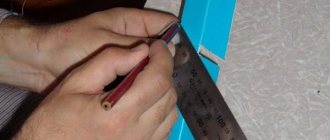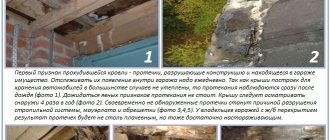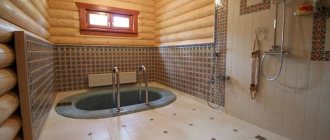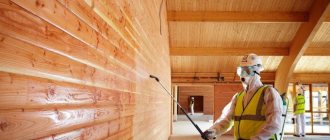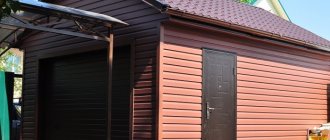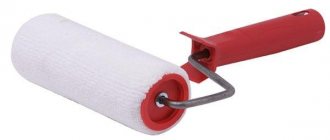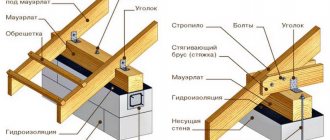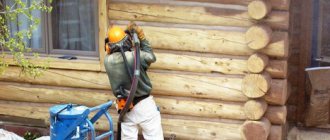Wood is a unique natural material; it creates a healthy microclimate in a room, fills it with an indescribable aroma, and gives it beauty and aesthetics. However, wooden structures have one very significant drawback: under the influence of time and bad weather, they begin to rot, darken and collapse. This can be easily avoided if you take care of wood protection in a timely manner. In order for a wooden house to retain its original appearance for a long time, it must be properly processed. Sanding a log frame from the outside and inside is a mandatory step in preparing the structure for long service. What is grinding, what is the technology for its implementation, what tools and when to perform the work, you will learn about this from the article.
Why is grinding needed?
Many people are concerned with the question: why polish a log house? There are many knots, irregularities and other defects on the surface of the logs that spoil the appearance of the structure and can be removed by sanding. Not only houses made of debarked logs and unplaned timber need sanding, but also houses made of any other lumber, regardless of its quality.
This operation is especially important for solid and profile timber with natural moisture. A house made of professional timber, left for a long time without chemical impregnation, becomes covered with an unsightly blue coating, which is removed by sanding. However, a house made of imitation timber will not look perfect without sanding.
On the surface of even lumber processed during the production process there are roughnesses, uneven color, cracks and chips, which cannot be removed without sanding. The sanded surface is an excellent basis for subsequent painting work. Painting a log frame without sanding can cause a short service life of the coating.
Sanding a wooden house allows you to solve many problems at once:
- level the surface of logs or beams, make it perfectly smooth;
- discover all the beauty of the natural texture of wood, which, under the influence of sanding, becomes more saturated and bright;
- remove fibers, roughness, knots and other minor defects;
- remove visible blue stains, get rid of fungus and mold if they have already settled in the wood, and also prevent their formation;
- ensure better penetration of protective antiseptics and primers into the structure of the material;
- prepare the surface for painting and varnishing;
- renew the surface of the old log house.
Many people doubt whether it is necessary to sand a rounded log before painting, or whether paint can be applied to wood without prior preparation. Experts believe that sanding is necessary before painting any lumber. It is necessary to ensure good adhesion of the paint and varnish material to the surface. The paint will lie unevenly on an unsanded surface, and all the unevenness of the wood will appear on the front layer.
Is it necessary to sand wood before painting?
In order for the paint or glaze to be absorbed and lay on the surface of the wood, performing all the declared protective and aesthetic functions in full, it is necessary to prepare the wood in advance and follow the application technology recommended by the manufacturer:
First stage: sanding the wood
Any wood that was processed using machines or manually before painting: for example, logs, timber, lining, blockhouse, has compressed wood fibers that form a surface comparable in its properties to film or glass. This makes it difficult to saturate wood with biocidal and paint-and-varnish compositions to a sufficient depth, saturating wood with a concentration lower than necessary for long-term protection from mold, blue stains and ultraviolet radiation. Sanding opens the pores on the surface of the wood and promotes maximum penetration of the compounds. Coatings applied to unsanded wood have insufficient adhesion and may peel off after a certain time. Sanding increases the service life of paint and varnish coatings by almost 2 times. Test stains on wood - on sanded and unsanded areas - help to understand the difference.
When to Sand
The first work that is performed at the construction stage or immediately after the construction of a log or timber house is the initial caulking of the roof joints. Sanding can begin only after the wooden house has undergone shrinkage and the wood has completely dried. This condition is especially important to comply with if a house or bathhouse is built from logs of natural moisture.
Undried wood does not allow for high-quality sanding; it must be allowed to settle and dry. This can take from six months to two years, depending on the time of installation and the moisture content of the wood. During drying, fibers rise in the wood and all its defects appear, which are easily removed during the sanding process.
Profiled timber can be sanded no earlier than 10-12 months after construction. If the house is made of glued or dried rounded timber, you can start sanding immediately after it is placed under the roof and caulked. A house made of laminated veneer lumber exhibits slight shrinkage, which cannot lead to significant deformation of the walls.
A polished surface cannot remain untreated for a long time. Within a week after sanding, the logs of the log house must be treated with an antiseptic composition. If you miss time, the wood will begin to darken and acquire a blue tint.
Sanding of logs must be carried out not only after the construction of a new house, but also after 5-7 years of operation of the building, when the time comes to change the old wall covering. Sanding removes old paintwork, lightens the color of the wood, and prepares it for painting.
Do I need to sand?
There are several types of wooden houses, which are subsequently subject to treatment with protective agents:
- frame houses covered with wood materials;
- log, from natural or rounded logs;
- lumber, from sawn or profiled timber of natural moisture;
- lumber, from laminated profiled timber.
Frame houses are usually sheathed with dry materials that can be processed immediately. These can be sheets of moisture-resistant plywood or planed profiled boards. Often such materials are treated with protective and decorative agents in advance, before they are mounted on the frame. In this case, grinding is not necessary.
Natural and rounded logs
Houses from natural logs are made using debarked timber of natural moisture. They shrink for a very long time, and drying takes 2-3 years. To reduce drying time, log houses made from such logs are usually installed in winter, when the moisture content of the wood is lowest. But in any case, processing of such a log house will occur only after drying and polishing.
A rounded log is made from a regular log by processing it on special machines. According to the principle of operation, they are similar to lathes. In this case, the top layer of wood is removed, and the log has the same diameter along its entire length. Removing the outer layer removes the strongest fibers. Protection of such a log from external influences is mandatory. But since the humidity of the rounded log is high, it also has to be dried naturally, that is, already laid in the log houses. During drying, the surface of the log may take on a uniform brown color, so treatment with protective compounds is possible only after sanding the rounded log.
Natural moisture timber
The timber is obtained by cutting a log at a sawmill. Drying of such logs occurs under natural conditions. In this case, the core is used to make timber, and the layers lying closer to the outer fibers are used to produce boards. Often the timber is then passed through special machines that give it a special profile. Thanks to this, it acquires grooves on the lower surface and tenons on the upper. When assembling a log house, the tenons are tightly inserted into the grooves, thereby ensuring the installation of warm, waterproof and windproof seams.
Since ordinary logs with natural moisture are used to produce timber, a log house made from such material must also be dried. Due to the fact that the density of the timber is usually less than the density of the surface of the log, drying occurs a little faster. However, during drying the timber still manages to darken. And in this case, before treating the log house with protective agents, it must be sanded.
Glued laminated timber
Glued laminated timber is obtained from boards or their scraps. In appearance and structure it resembles a layer cake. Such timber is very convenient to work with, since the fibers of the boards that make it up are located in different directions. The timber does not warp or behave when exposed to temperature and humidity.
Before gluing, the boards are usually dried and planed, since smooth surfaces adhere better. After gluing, the timber structure is kept for some time in the drying chamber, and then subjected to profiling, as a result of which, as in the case described above, the product acquires grooves and tenons.
Note! After several dryings, the wood of laminated veneer lumber already has low moisture content, so a log house made from this material can be treated with protective agents immediately after assembly.
However, even in this case it is not always possible to do without grinding work. The fact is that while the frame, rafters are being installed, the roofing, windows, doors are being installed and the outside is being processed, the surface of the timber inside the room can still change its appearance. Therefore, during finishing work inside the house, the walls made of timber are polished. As a result, the surface becomes perfectly flat, smooth and light.
Basic rules and methods for polishing a log frame
Grinding a log frame includes three stages:
- Rough peeling, initial rough surface treatment is performed.
- The main processing consists of smoothing out irregularities and leveling the base.
- Finishing and preparing the surface for the application of antiseptics and coloring agents.
Many people wonder whether final sanding of a log house is necessary, because after average processing the wood is already smooth. To get a beautiful and high-quality coating, the surface must be perfectly smooth. This cannot be achieved without finishing.
Several factors influence grinding speed:
- type of wood processed;
- surface area and relief;
- type and power of the tool;
- grinding and tool handling skills;
- the presence of resin in wood.
The grinding tool is selected depending on the type of lumber used for construction.
- For grinding a log house and a bathhouse made of chopped logs, an angle grinder is suitable, or, in another way, an ordinary grinder with special abrasive attachments. For each type of work, there are wheels of different numbers, which differ in grain size. You can plan the rough part of the bark, remove knots and other large defects in the material using abrasive with coarse grain No. 40-60. The same abrasive is used to sand the surface when peeling off the old paintwork. Medium grinding is performed with a tool with discs No. 80 with fine abrasive. Finishing sanding is done using wheels No. 100-120 or manually using sandpaper with the finest grain size.
- A rounded log has a perfectly smooth surface, which can be easily damaged by any careless movement of the grinder. In this regard, it is better to grind the osb using an eccentric grinder. This tool is capable of performing the most delicate processing; as a rule, it is an eccentric machine that is used to polish a log house.
- Grinding of unplaned, profiled and laminated timber is carried out using the same grinder. The angle grinder provides high grinding performance. However, if you do not have the skills to use this power tool, it is better to use surface grinders and belt sanders, which do an excellent job of processing flat surfaces. It is best to sand hard-to-reach places in the corners of a log house not with a power tool, but with a block with sanding paper.
Self-grinding mistakes
The technology of grinding a log frame at first glance seems quite simple, and many mistakenly believe that this work does not require special skills and experience. Actually this is not true. To achieve the desired effect by sanding, skill and precision are required. A person who does not have special qualifications and experience, including the skills to use a grinding tool, can only cause harm with his unprofessionalism.
If sanded incorrectly, unwanted chips, depressions and grooves may appear on the surface, which will affect the appearance. If the surface is not smooth enough, the absorption of antiseptics will deteriorate and paint consumption will increase. Sanding hard-to-reach places is especially difficult; it is not so easy to sand a house in the corners and ends.
During grinding, no matter how carefully the surface is sanded, dust will inevitably appear, so it is necessary to use respiratory protective equipment when working. In addition, you will have to stock up on a large number of attachments of different sizes, since they have to be changed very often. The grain quickly wears out and becomes clogged with flying dust and resin. This results in high costs, since replacement wheels are not cheap.
Surface degumming
Conifers are known to contain large amounts of natural resins. On the one hand, this circumstance is an advantage, since the resin content protects the tree from rotting and mold formation. But on the other hand, resin prevents good adhesion of paint to wood, and when sanding it spreads over the surface and spoils the appearance of the wood. Therefore, before processing the needles with a grinder, it is necessary to remove excess resin.
How to remove resin from a log before sanding? Suitable solvents for this are: acetone, white spirit, turpentine, purified gasoline. You just need to apply the selected product to the wooden surface, and rinse off the residue with warm water.
Professional grinding services
Specialists will do a great job creating a beautiful and smooth surface of a wooden house. If you need to sand a log house or a house made of timber in Moscow or the Moscow region, the experienced craftsmen of our company will perform sanding of any complexity at a high professional level.
We cannot display this gallery
In our work, we use professional power tools with the necessary set of attachments of different diameters and grain sizes, which ensures uniform grinding. Each stage of grinding is carefully controlled, which allows you to achieve the best result.
We provide a guarantee for all types of work. Our company employs experienced teams of craftsmen of Slavic nationality, with specialized education and high qualifications. You can contact us, as well as call a specialist for free, using the coordinates located on the “Contacts” .
Unfortunately, there are many companies in our market that provide low quality services. Customers often turn to us with a request to redo the work for an inferior contractor. In this case, we can recommend seeking legal advice from our partners. We have already resorted to legal services to resolve disputes with unscrupulous contractors. And in all three court cases the conflict was resolved in our favor!
